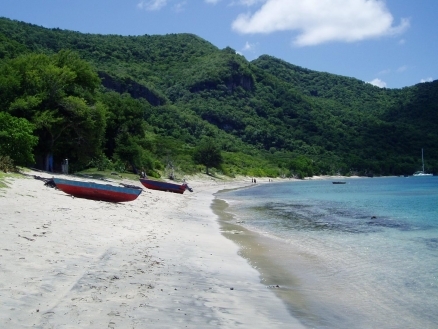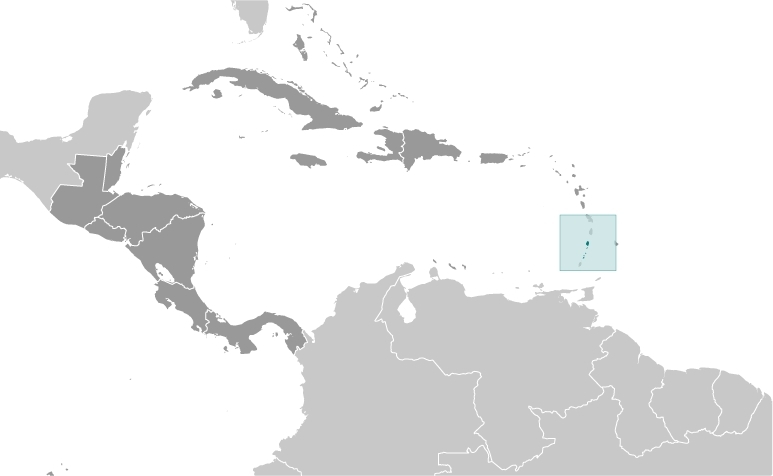Saint Vincent and the Grenadines
Countries and Regions of the World Collection  Saint Vincent and the Grenadines is a Caribbean nation of one hundred and four thousand people composed of a main island (St. Vincent) and a number of smaller Islands (two thirds of "the Grenadines") - in total there are 32 islands and cays.
Saint Vincent and the Grenadines is a Caribbean nation of one hundred and four thousand people composed of a main island (St. Vincent) and a number of smaller Islands (two thirds of "the Grenadines") - in total there are 32 islands and cays.
The islands are located in the Caribbean Sea, and are part of the Windward Islands of the Lesser Antilles chain of the West Indies.
The country has a French and British colonial history and is now part of the Commonwealth of Nations and CARICOM.
Resistance by native Caribs prevented colonization on St. Vincent until 1719.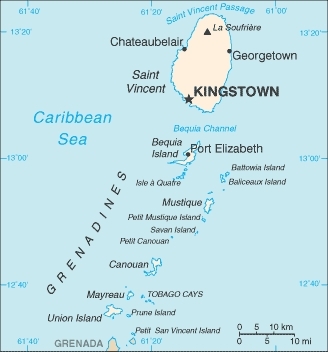
Disputed between France and the United Kingdom for most of the 18th century, the island was ceded to the latter in 1783.
Between 1960 and 1962, Saint Vincent and the Grenadines was a separate administrative unit of the Federation of the West Indies. Autonomy was granted in 1969 and independence in 1979.
Its major environmental issues include pollution of coastal waters and shorelines from discharges by pleasure yachts and other effluents. In some areas, water pollution is severe enough to make swimming hazardous to human health.
Soufriere volcano on the island of Saint Vincent is a constant threat.
The administration of the islands of the Grenadines group is divided between Saint Vincent and the Grenadines and Grenada.
Contents
Geography
Location: Caribbean, islands between the Caribbean Sea and North Atlantic Ocean, north of Trinidad and Tobago
Geographic Coordinates:13 15 N, 61 12 W
Area: 389 sq km (Saint Vincent 344 sq km) 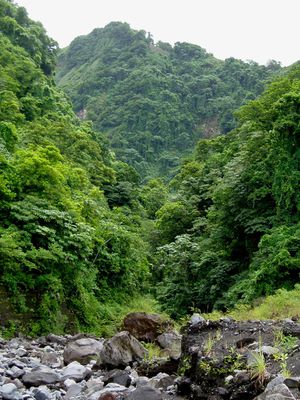 A view of the jungle on St. Vincent, taken from the beach. The rocks in the foreground are the remains of lava flows from a 1979 eruption of La Soufriere volcano.
A view of the jungle on St. Vincent, taken from the beach. The rocks in the foreground are the remains of lava flows from a 1979 eruption of La Soufriere volcano.
arable land: 17.95%
permanent crops: 17.95%
other: 64.1% (2005)
Coastline:84 km
Maritime Claims:
Territorial sea to 12 nautical miles;
contiguous zone to 24 nautical miles;
exclusive economic zone to 200 nautical miles;
continental shelf to 200 nautical miles
Natural Hazards: hurricanes; Soufriere volcano on the island of Saint Vincent is a constant threat
Terrain: volcanic, mountainous. The highest point is (La Soufriere 1,234 m)
Climate: Tropical; little seasonal temperature variation; rainy season (May to November) tropical; little seasonal temperature variation; rainy season (May to November)
Capital: Kingstown
Ecology and Biodiversity
See also: Biological diversity in the Caribbean Islands People and SocietyPopulation: 103,537 (July 2012 est.) Most Vincentians are the descendants of African slaves brought to the island to work on plantations. There also are a few white descendants of English colonists, as well as some East Indians, Carib Indians, and a sizable minority of mixed race. The country's official language is English, but a French patois may be heard on some of the Grenadine Islands. Age Structure: 0-14 years: 24.5% (male 12,842/female 12,638) |
File:Scale |
Population Growth Rate: -0.313% (2012 est.)
Birthrate: 14.36 births/1,000 population (2012 est.)
Death Rate: 7.02 deaths/1,000 population (July 2012 est.)
Net Migration Rate: -10.47 migrant(s)/1,000 population (2012 est.)
Life Expectancy at Birth: 74.39 years
male: 72.48 years
female: 76.36 years (2012 est.)
Total Fertility Rate: 1.89 children born/woman (2012 est.)
Languages:English, French patois
Literacy: 96% (1970 est.)
Urbanization: 49% of total population (2010) growing at a 1% annual rate of change (2010-15 est.)
History
Carib Indians aggressively prevented European settlement on St. Vincent until the 18th century. African slaves--whether shipwrecked or escaped from St. Lucia and Grenada and seeking refuge in St. Vincent--intermarried with the Caribs and became known as "black Caribs." Beginning in 1719, French settlers cultivated coffee, tobacco, indigo, cotton, and sugar on plantations worked by African slaves. In 1763, St. Vincent was ceded to Britain. Restored to French rule in 1779, St. Vincent was regained by the British under the Treaty of Versailles in 1783. Conflict between the British and the black Caribs continued until 1796, when General Abercrombie crushed a revolt fomented by the French radical Victor Hugues. More than 5,000 black Caribs were eventually deported to Roatan, an island off the coast of Honduras.
Slavery was abolished in 1834; the resulting labor shortages on the plantations attracted Portuguese immigrants in the 1840s and east Indians in the 1860s. Conditions remained harsh for both former slaves and immigrant agricultural workers, as depressed world sugar prices kept the economy stagnant until the turn of the century.
From 1763 until independence, St. Vincent passed through various stages of colonial status under the British. A representative assembly was authorized in 1776, Crown Colony government installed in 1877, a legislative council created in 1925, and universal adult suffrage granted in 1951.
During this period, the British made several unsuccessful attempts to affiliate St. Vincent with other Windward Islands in order to govern the region through a unified administration. The most notable was the West Indies Federation, which collapsed in 1962. St. Vincent was granted associate statehood status in 1969, giving it complete control over its internal affairs. Following a referendum in 1979, St. Vincent and the Grenadines became the last of the Windward Islands to gain independence.
Natural disasters have plagued the country throughout the 20th century. In 1902, the La Soufriere volcano erupted, killing 2,000 people. Much farmland was damaged, and the economy deteriorated. In April 1979, La Soufriere erupted again. Although no one was killed, thousands had to be evacuated, and there was extensive agricultural damage. In 1980 and 1987, hurricanes devastated banana and coconut plantations; 1998 and 1999 also saw very active hurricane seasons, with Hurricane Lenny in 1999 causing extensive damage to the west coast of the island.
The People's Political Party (PPP), founded in 1952 by Ebenezer Joshua, was the first major political party in St. Vincent. The PPP had its roots in the labor movement and was in the forefront of national policy prior to independence, winning elections from 1957 through 1966. With the development of a more conservative black middle class, however, the party began to lose support steadily, until it collapsed after a rout in the 1979 elections. The party dissolved itself in 1984.
Founded in 1955, the St. Vincent Labour Party (SVLP), under R. Milton Cato, gained the support of the middle class. With a conservative law-and-order message and a pro-Western foreign policy, the SVLP dominated politics from the mid-1960s until the mid-1980s. Following victories in the 1967 and 1974 elections, the SVLP led the island to independence, winning the first post-independence election in 1979. Expecting an easy victory for the SVLP in 1984, Cato called early elections. The results were surprising: with a record 89% voter turnout, James F. Mitchell's New Democratic Party (NDP) won nine seats in the House of Assembly.
Bolstered by a resurgent economy in the mid-1980s, Mitchell led his party to an unprecedented sweep of all 15 House of Assembly seats in the 1989 elections. The opposition emerged from the election weakened and fragmented but was able to win three seats during the February 1994 elections under a "unity" coalition. In 1998, Prime Minister Mitchell and the NDP were returned to power for an unprecedented fourth term but with only a slim margin of 8 seats to 7 seats for the Unity Labour Party (ULP). The NDP was able to accomplish a return to power while receiving a lesser share of the popular vote, approximately 45% to the ULP's 55%.
In March 2001, the ULP, led by Ralph Gonsalves, assumed power after winning 12 of the 15 seats in Parliament. In the December 2005 parliamentary elections, Prime Minister Gonsalves and the ULP retained their 12-3 majority over the NDP. In the December 2010 parliamentary elections, Prime Minister Gonsalves and the ULP retained a slight majority, winning 8 of the 15 seats. The main opposition party, the NDP, won the remaining 7 seats.
Government
Government Type: parliamentary democracy and a Commonwealth realm.
St. Vincent and the Grenadines is a parliamentary democracy within the Commonwealth of Nations. Queen Elizabeth II is head of state and is represented on the island by a governor general, an office with mostly ceremonial functions. Control of the government rests with the prime minister and the cabinet.
The parliament is a unicameral body, consisting of 15 elected members and six appointed senators. The governor general appoints senators, four on the advice of the prime minister and two on the advice of the leader of the opposition. The parliamentary term of office is 5 years, although the prime minister may call elections at any time.
As in other English-speaking Caribbean countries, the judiciary in St. Vincent is rooted in British common law. There are 11 courts in three magisterial districts. The Eastern Caribbean Supreme Court, comprising a High Court and a Court of Appeals, is known in St. Vincent as the St. Vincent and the Grenadines Supreme Court. The court of last resort is the judicial committee of Her Majesty's Privy Council in London.
There is no local government in St. Vincent, and all six parishes are administered by the central government.
Capital: Kingstown - 28,000 (2009)
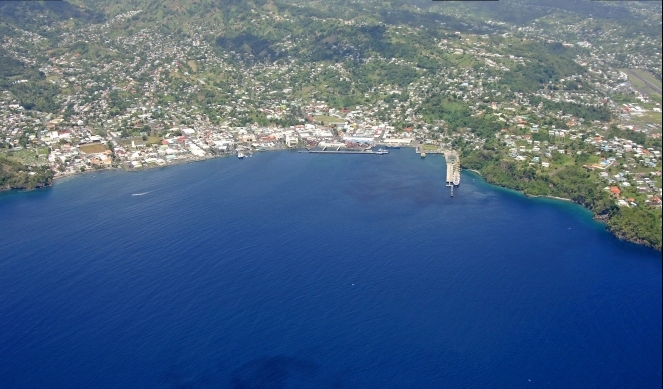
Kingstown Bay. Source: Wikimedia Commons.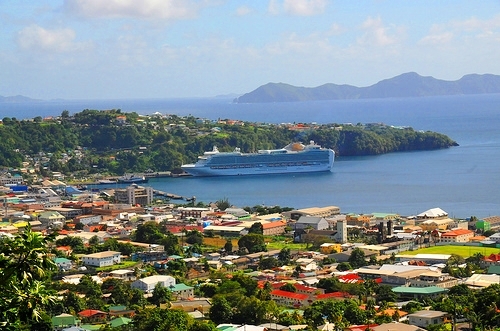
Kingstown Bay. Source: Wikimedia Commons
|
Administrative divisions: 6 parishes;
Independence Date: 27 October 1979 (from the UK) Legal System: English common law. Saint Vincent and the Grenadines has not submitted an International Court of Justice (ICJ) jurisdiction declaration; but accepts International criminal court (ICCt) jurisdiction. International Environmental AgreementsSt. Vincent and the Grenadines is party to international agreements on: Biodiversity, Climate Change, Climate Change-Kyoto Protocol, Desertification, Endangered Species, Environmental Modification, Hazardous Wastes, Law of the Sea, Marine Dumping, Ozone Layer Protection, Ship Pollution, and Whaling. WaterThe total annual production from all currently used water resources is 9.95 million cubic meters (m3), with a storage capacity of about 5 million m3. All production is targeted for consumption, there being no water available from the system to support agricultural production. There is no official record of water use by sectors. Government institutions are estimated to use 1.6 million m3, unaccounted-for water is estimated at about 1.8 million m3, leakages 0.5 and domestic consumption at 5.3 million m3. Total Renewable Water Resources: 0.01 cu km/yr (1995) Per Capita Freshwater Withdrawal: 83 cu m/yr (1995) |
Source: Wikimedia Commons |

The beach of Bequia, one of the larger islands of the Grenadines of St. Vincent. The object at the lower right is space junk, a piece of a European rocket booster that washed up on the beach.
Agriculture
Agricultural products: bananas, coconuts, sweet potatoes, spices; small numbers of cattle, sheep, pigs, goats; fish
Irrigated Land: 10 sq km (2008)
Resources
Natural Resources: hydropower, cropland
Land Use:
arable land: 17.95%
permanent crops: 17.95%
other: 64.1% (2005)
Economy
Banana production employs upwards of 60% of the work force and accounts for 50% of merchandise exports in St. Vincent and the Grenadines, with an emphasis on the main island of St. Vincent. Such reliance on one crop has made the economy vulnerable to fluctuations in banana prices and reduced European Union trade preferences. To combat these vulnerabilities, the Government of St. Vincent and the Grenadines is focused on diversifying its economy away from reliance on bananas. Recently, there has been a parallel reduction in licit agriculture and a rise in marijuana cultivation, making St. Vincent and the Grenadines the largest marijuana producer in the Eastern Caribbean.
In contrast to developments on the main island, tourism in the Grenadines has grown to become a very important part of the economy, and the chief earner of foreign exchange for the country as a whole. The Grenadines have become a favorite of high-end tourism and the focus of new development in the country. Super-luxury resorts, yachting tourism, and a commitment by the government to rehabilitate and protect the Tobago Keys as a national park have all contributed to strong tourism returns in the Grenadines.
St. Vincent and the Grenadines' currency is the Eastern Caribbean Dollar (EC$), a regional currency shared among members of the Eastern Caribbean Currency Union (ECCU). The Eastern Caribbean Central Bank (ECCB) issues the EC$, manages monetary policy, and regulates and supervises commercial banking activities in its member countries. The ECCB has kept the EC$ pegged at EC$2.7=U.S. $1.
St. Vincent and the Grenadines is a beneficiary of the U.S. Caribbean Basin Initiative that grants duty-free entry into the United States for many goods. St. Vincent and the Grenadines also belongs to the predominantly English-speaking Caribbean Community and Common Market (CARICOM) and the CARICOM Single Market and Economy (CSME).
GDP: (Purchasing Power Parity): $1.224 billion (2011 est.)
GDP (official exchange rate): $700 million (2011 est.)
GDP- per capita (PPP): $11,700 (2011 est.)
GDP- composition by sector:
agriculture: 7.6%
industry: 25.3%
services: 67% (2011 est.)
Industries: tourism; food processing, cement, furniture, clothing, starch
Natural Resources:hydropower, cropland
Currency: East Caribbean dollars (XCD)
